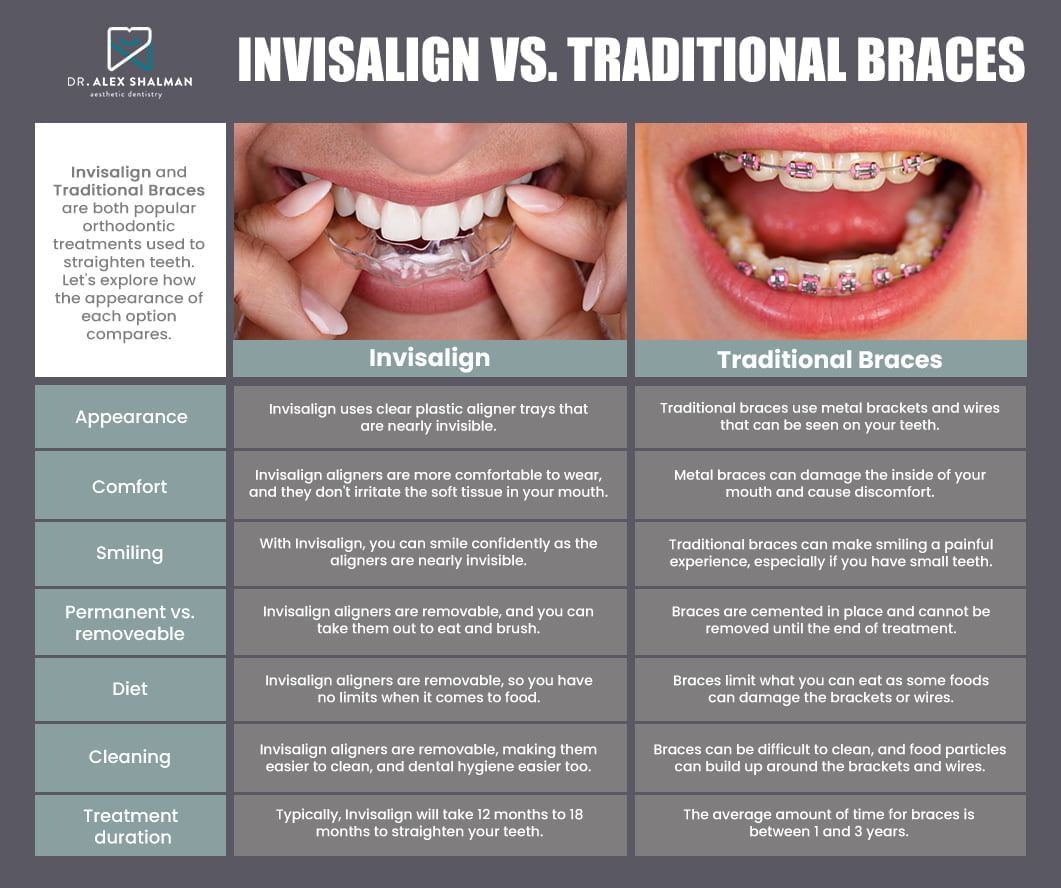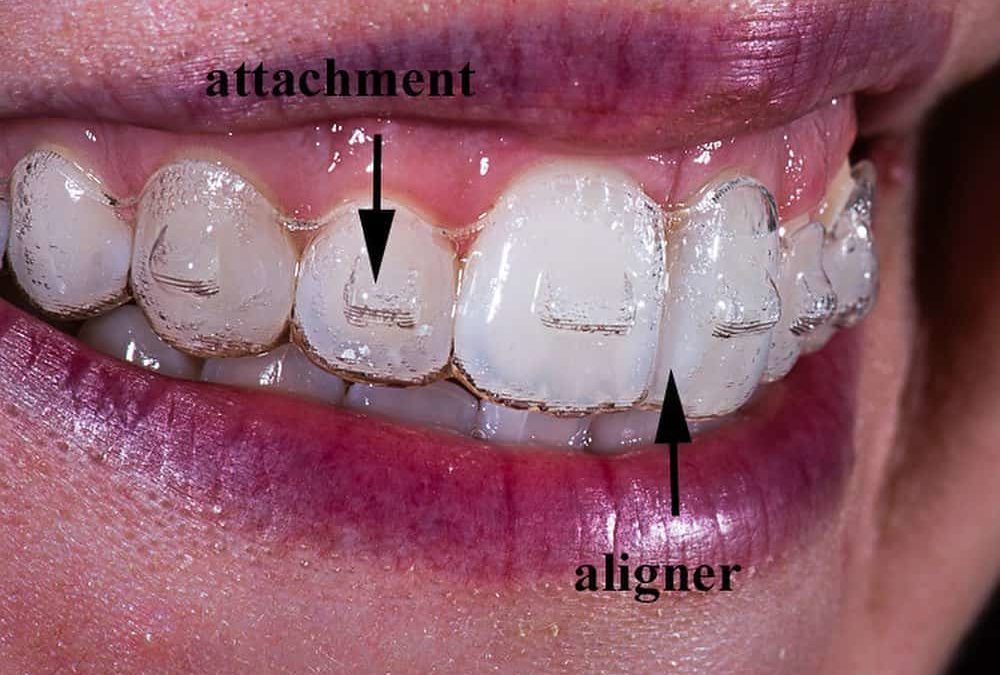Discover the Advantages of Invisalign for a Perfect Smile Transformation
Discover the Advantages of Invisalign for a Perfect Smile Transformation
Blog Article
Invisalign vs. Standard Braces: Which Option Is Right for You?
When considering orthodontic therapy, the selection in between Invisalign and standard braces provides several essential elements that merit careful assessment. Invisalign supplies a very discreet alternative with removable aligners, while typical dental braces offer a more noticeable yet reliable service for severe imbalance.
Summary of Treatment Options

On the other hand, conventional dental braces contain steel brackets and wires that are bound to the teeth. This approach applies constant stress gradually to attain positioning. While efficient for intricate orthodontic issues, standard dental braces require routine gos to for modifications and can posture challenges in maintaining oral hygiene due to the difficulty of cleaning up around braces and cords.
Both choices have their qualities, and the choice typically rests on specific dental conditions, way of life choices, and person compliance. Ultimately, seeking advice from an orthodontic professional is crucial for identifying the most ideal therapy strategy tailored to private requirements. Comprehending the nuances of each choice can dramatically influence the overall success of orthodontic therapy.
Aesthetic Considerations
A considerable aspect influencing the choice between Invisalign and conventional braces is the aesthetic appeal each therapy supplies. Invisalign aligners are crafted from clear plastic, making them basically unseen when used. This very discreet appearance is especially attracting grownups and teens that may feel uncomfortable regarding their orthodontic treatment. The ability to keep a natural smile throughout the alignment procedure can considerably enhance the patient's self-confidence in social and specialist settings.
On the other hand, standard dental braces include metal brackets and cables, which can be much more recognizable. While advancements in orthodontic technology have actually caused the advancement of smaller sized brackets and tinted elastics, traditional dental braces still keep a more obvious profile. For some people, the visibility of dental braces may hinder them from seeking essential treatment.
Eventually, the choice between Invisalign and typical braces may depend upon personal preferences regarding visual appeals. Patients that prioritize discretion frequently favor Invisalign, while those who are less concerned regarding visibility might go with traditional dental braces. Recognizing the aesthetic ramifications of each choice is vital for making an informed decision that lines up with one's way of living and choices.
Comfort and Convenience

In terms of convenience, Invisalign aligners are detachable, allowing people to appreciate their preferred foods without limitation and keep ideal dental hygiene. Brushing and flossing are streamlined, as the aligners can be obtained during these regimens, whereas typical braces require mindful navigating around brackets and cords.
In addition, Invisalign's modern system enables less orthodontic check outs. Clients usually get numerous sets of aligners at the same time, which can enhance the treatment procedure and decrease time invested in the orthodontist's chair. In contrast, typical dental braces necessitate routine adjustments, making them much less convenient for those with hectic schedules. Invisalign. Generally, the comfort and ease of Invisalign make it an attractive choice for lots of people seeking orthodontic therapy.
Treatment Period and Effectiveness
While both Invisalign and standard dental braces work in correcting dental imbalances, the duration of therapy can vary significantly in between the 2 options. Typically, Invisalign treatment can take anywhere from 12 to 18 months, depending upon the intricacy of why not try these out the case. The clear aligners work by slowly moving teeth right into their wanted positions, and regular follow-ups with an orthodontist assistance make sure progress stays on the right track.
In comparison, typical dental braces often this link require a longer commitment, typically ranging from 18 months to 3 years. This results from their fixed nature and the use of brackets and wires, which can be extra effective for extreme imbalances and intricate instances (Invisalign). The therapy efficiency of standard dental braces is well-documented, as they enable for accurate modifications and greater control over tooth movement
Ultimately, the choice between Invisalign and conventional braces might rest on both the expected treatment duration and the specific oral problems at hand. Consulting with an orthodontist is vital, as they can supply tailored recommendations based on individual demands, making certain the selected technique aligns with wanted timeframes and outcomes.
Cost Contrast and Insurance Policy Choices
Expense plays a considerable duty in the decision-making procedure for individuals considering orthodontic therapy, whether going with Invisalign or conventional braces. Usually, the price of Invisalign varieties from $3,000 to $8,000, while standard dental braces typically set you back in between $2,000 and $6,000. Variables affecting these expenses include the complexity of the situation, the duration of treatment, and geographical place.
Many dental insurance policy plans give partial protection for orthodontic therapies, but the specifics can differ extensively. Generally, typical braces may be much more often covered by insurance plans compared to Invisalign, which some insurance providers categorize as an aesthetic procedure.
Furthermore, numerous orthodontic methods use flexible payment strategies, making both treatment alternatives more obtainable. People should make inquiries concerning possible financing options and price cuts for in advance repayments. Reviewing the overall cost, consisting of insurance coverage benefits and layaway plan, is crucial for making an educated decision that lines up with both aesthetic choices and spending plan considerations.

Verdict
In recap, the choice in between Invisalign and standard braces rests on numerous factors, including aesthetic choices, convenience, therapy period, and expense. Invisalign provides a discreet, detachable alternative that promotes dental hygiene and dietary flexibility, while typical dental braces may be see this page better for complex oral problems and typically come with a lower price factor. Eventually, examination with an orthodontist is necessary to examine private situations and identify one of the most suitable treatment alternative for attaining ideal dental alignment.
When thinking about orthodontic treatment, the choice between Invisalign and conventional braces offers numerous crucial elements that merit careful assessment.Comparing Invisalign and traditional braces reveals distinct treatment options for orthodontic correction.While both Invisalign and typical dental braces are efficient in correcting oral imbalances, the duration of treatment can differ dramatically between the 2 choices.Expense plays a considerable role in the decision-making process for people taking into consideration orthodontic therapy, whether choosing for Invisalign or traditional dental braces.In summary, the choice between Invisalign and traditional dental braces pivots on multiple variables, including visual choices, convenience, therapy duration, and price.
Report this page